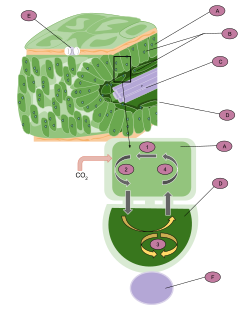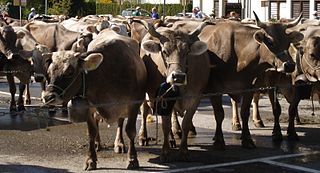
Spathodea is a monotypic genus in the flowering plant family Bignoniaceae. The single species it contains, Spathodea campanulata, is commonly known as the African tulip tree, fountain tree, pichkari or Nandi flame. The tree grows between 7–25 m (23–82 ft) tall and is native to tropical dry forests of Africa. It has been nominated as among 100 of the "World's Worst" invaders.

Ornamental grasses are grasses grown as ornamental plants. They have become increasingly popular in gardens in recent years. Ornamental grasses are popular in many colder hardiness zones for their resilience to cold temperatures and aesthetic value throughout fall and winter seasons.

Pennisetum is a widespread genus of plants in the grass family, native to tropical and warm temperate regions of the world. They are known commonly as fountaingrasses
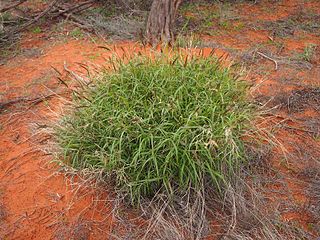
Cenchrus ciliaris is a species of grass native to most of Africa, southern Asia, southern Iran, and the extreme south of Europe (Sicily). Other names by which this grass is known include dhaman grass, anjan grass and koluk katai.

There are a number of Australian species that have become invasive when introduced into outside Australia or outside Oceania.

Clidemia hirta, commonly called soapbush or Koster's curse, is a perennial shrub. It is an invasive plant species in many tropical regions of the world, creating serious damage.

The tropical grass species Pennisetum clandestinum is known by several common names, most often kikuyu grass, as it is native to the region of East Africa that is home to the Kikuyu people. Because of its rapid growth and aggressive nature, it is categorised as a noxious weed in some regions. However, it is also a popular garden lawn species in Australia, New Zealand, South Africa and the southern region of California in the United States, as it is inexpensive and drought-tolerant. In addition, it is useful as pasture for livestock grazing and serves as a food source for many avian species, including the long-tailed widowbird. The flowering culms are very short and "hidden" amongst the leaves, giving this species its specific epithet (clandestinum).

Mezoneuron kavaiense is a rare species of flowering plant in the pea family, Fabaceae, that is endemic to Hawaii. Common names include Uhiuhi, Kāwaʻu (Maui), and Kea (Maui). It is threatened by invasive species, particularly feral ungulates.
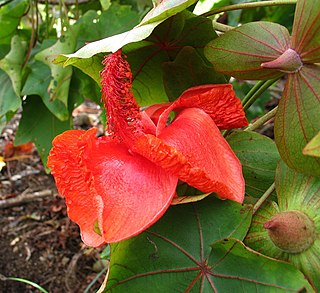
Kokia drynarioides, commonly known as Hawaiian tree cotton, is a species of flowering plant in the mallow family, Malvaceae, that is endemic to the Big Island of Hawaii. It inhabits dry forests at elevations of 455–1,915 m (1,493–6,283 ft). Associated plants include ʻāheahea, ʻaʻaliʻi, hala pepe, wiliwili, uhiuhi, kōlea, ʻaiea, kuluʻī, ʻālaʻa, ʻohe kukuluāeʻo, māmane, and maua. It is threatened by habitat loss and competition with invasive species, such as Fountain Grass.

Gardenia brighamii, commonly known as nānū, naʻu, or forest gardenia, is a species of flowering plant in the coffee family, Rubiaceae, that is endemic to Hawaii.

Bulbostylis neglecta, neglected tuft sedge locally, is an endemic member of the Cyperaceae of Saint Helena in the South Atlantic.

Pennisetum alopecuroides, the Chinese pennisetum, Chinese fountaingrass, dwarf fountain grass, foxtail fountain grass, or swamp foxtail grass, is a species of perennial grass native to Asia and Australia. Culms are erect, and 60–100 cm long; leaf-blades are erect or drooping; flat, or conduplicate, or involute; and from 10–45 cm long by 3–6 mm wide. Pronunciation: Pennisetum (pen-ih-SEE-tum) alopecuroides (al-oh-pek-yur-OY-deez)
The mission of Arizona Native Plant Society (AZNPS) is to promote knowledge, appreciation, conservation and restoration of Arizona native plants and their habitats, as well as the use of native plants in urban landscapes and gardens. Among its initiatives are the Plant Atlas Project of Arizona (PAPAZ), which trains AZNPS volunteers in botanical fieldwork; publication of booklets and brochures promoting the use of native plants; compilation and web publication of plant lists for various natural areas of Arizona and northern Mexico; grants for publication assistance and research; and pioneering work in invasive species education and removal.

Isodendrion pyrifolium is a rare species of flowering plant in the violet family known by the common name wahine noho kula. It is endemic to Hawaii, where it is known only from the island of Hawaii. It is a federally listed endangered species of the United States.
Silene hawaiiensis is a rare species of flowering plant in the pink family known by the common names Hawai'i catchfly, Hawaiian catchfly and Sherff's catchfly. It is endemic to Hawaii, where it is known only from the island of Hawaii. It is threatened by the degradation of its habitat and it is a federally listed threatened species of the United States.

Silene lanceolata is a rare species of flowering plant in the pink family known by the common names Kauai catchfly and lanceolate catchfly. It is endemic to Hawaii, where it is known only from Oahu, Molokai, and Hawaii, having been extirpated from Kauai and Lanai. It is threatened by the degradation of its habitat and it is a federally listed endangered species of the United States.

Solanum incompletum is a rare species of flowering plant in the nightshade family known by the common names thorny popolo and popolo ku mai. It is endemic to Hawaii, where it occurs today on the islands of Maui, Lanai, and Hawaii. It is threatened by the destruction and degradation of its habitat. It is a federally listed endangered species of the United States.

Pennisetum polystachion, the mission grass, is a species of grass native to tropical Africa, and is an invasive species in Northern Australia and in Sri Lanka.
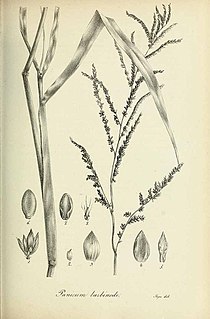
Brachiaria mutica is a species of grass known by the common names para grass, buffalo grass, Mauritius signal grass, pasto pare, malojilla, gramalote, parana, Carib grass, and Scotch grass. Despite its common name California grass, it does not occur in California; it is native to northern and central Africa and parts of the Middle East, where it is cultivated for fodder. It was introduced elsewhere and it is now cultivated throughout tropical regions of the world for this purpose.

